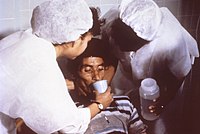
Photo from wikipedia
Fluid overload is associated with increased morbidity and mortality in hemodialysis (HD) patients. In-patient treatment of fluid overload was previously estimated to occur at a rate of 13.7 episodes/100 patient-years… Click to show full abstract
Fluid overload is associated with increased morbidity and mortality in hemodialysis (HD) patients. In-patient treatment of fluid overload was previously estimated to occur at a rate of 13.7 episodes/100 patient-years and estimated to cost $266 million over a 2.5-year period (Arneson 2010). We developed a model to predict which patients treated at a large dialysis provider are at imminent risk of hospitalization due to fluid overload and may benefit from additional interventions. We built a machine learning (ML) model using clinical and HD treatment data to identify which patients have the highest risk of hospital admission for fluid overload within 7 days of the current outpatient dialysis treatment. Next, we partnered with a team of remote nurses who perform chart reviews, needs identification, and communication outreach when warranted with the goal to reduce hospital admissions. Patients were identified from the ML model and displayed in a worklist on a computer dashboard, ranked by their risk score on that day. The computer dashboard also contained relevant clinical information to enhance the patient review process. Model results from prospective data (> 9M predictions in a two-month period) show the model has an area under the receiver operating curve (AUROC) of 0.79, sensitivity of 65%, and specificity of 78% (Figure 1). Weekly chart reviews increased 18% from 26 weeks before the pilot compared to 14 weeks after the pilot began; total communication outreach increased 31% across the same time frame. Further, the nurses using the dashboard anecdotally reported that the dashboard reduced the amount of time required to decide to perform a chart review or perform communication outreach. Our predictive model successfully identifies patients at high risk for fluid overload hospital admissions. Understanding the nurse workflow, how they manage this patient population, and which components can be made more efficient enabled them to increase the number of chart reviews and communication outreach.
Journal Title: Nephrology Dialysis Transplantation
Year Published: 2020
Link to full text (if available)
Share on Social Media: Sign Up to like & get
recommendations!